| |
LEGEND:
 |
 |
|
Link to a PDF document |
 |
 |
|
Link to non-governmental site and does not
necessarily represent the views of the CDC |

|
 |
| Adobe
Acrobat (TM) Reader needs to be installed on
your computer in order to read documents in PDF format.
Download the Reader.
|
|
 |
 |
 |

| 
| HIV/AIDS Surveillance in Injection Drug Users
(through 2006) |
 |
 |
|
Instructions for downloading and using
HIV/AIDS surveillance slides. Download the
complete slide set:
While the content is in the public domain and
no copyright restriction applies,
we do ask that users preserve the slides in
their current format and cite CDC as the
source.
|

Slide 1
Estimated Number of AIDS Cases among
Adults and Adolescents, by Transmission
Category 1985–2006—United States and
Dependent Areas
PDF
File
 or
PPT
File or
PPT
File |
|
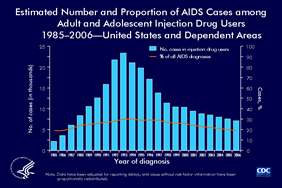
Slide 2
Estimated Number and Proportion of AIDS Cases among Adult and Adolescent Injection Drug Users, 1985–2006—United States and Dependent Areas
PDF
File
 or
PPT
File
or
PPT
File |
|

Slide 3
Estimated Number and Proportion of AIDS Cases, by Sex and Transmission Category among Adults and Adolescents, 2006—United States and Dependent Areas
PDF
File
 or
PPT
File or
PPT
File |
|

Slide 4
Estimated Number of AIDS Cases among Male Adult and Adolescent Injection Drug Users, by Race/Ethnicity, 2006—50 States and DC
PDF
File
 or
PPT
File or
PPT
File |
|

Slide 5
Estimated Number of AIDS Cases among Female Adult and Adolescent Injection Drug Users, by Race/Ethnicity, 2006—50 States and DC
PDF
File
 or
PPT
File or
PPT
File |
|

Slide 6
Proportion of AIDS Cases among Adults and Adolescents, by IDU-related Transmission Category, 2006—United States and Dependent Areas
PDF
File
 or
PPT
File or
PPT
File |
|

Slide 7
Proportion of AIDS Cases among Adults and Adolescents, by IDU-related Transmission Category, 2006—United States and Dependent Areas
PDF
File
 or
PPT
File or
PPT
File |
|
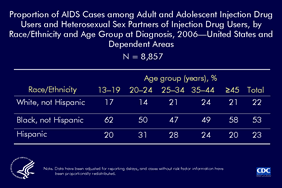
Slide 8
Proportion of AIDS Cases among Adult and Adolescent Injection Drug Users and Heterosexual Sex Partners of Injection Drug Users, by Race/Ethnicity and Age Group at Diagnosis, 2006—United States and Dependent Areas
PDF
File
 or
PPT
File
or
PPT
File |
|

Slide 9
Proportion of AIDS Cases among Adult and Adolescent Males, IDU-related Transmission Category and by Race/Ethnicity, 2002–2006—50 States and DC
PDF
File
 or
PPT
File or
PPT
File |
|

Slide 10
Proportion of AIDS Cases among Adult and Adolescent Females, by IDU-related Transmission Category and Race/Ethnicity, 2002–2006—50 States and DC
PDF File
 or
PPT
File or
PPT
File |
|

Slide 11
Estimated Number of AIDS Cases among Adult and Adolescent Injection Drug Users, by Area of Residence at Diagnosis, 2006—United States and Dependent Areas
PDF
File
 or
PPT
File or
PPT
File |
|
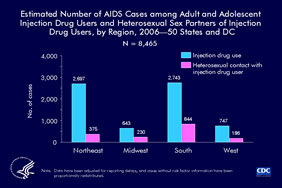
Slide 12
Estimated Number of AIDS Cases among Adult and Adolescent Injection Drug Users and Heterosexual Sex Partners of Injection Drug Users, by Region, 2006—50 States and DC
PDF
File
 or
PPT
File or
PPT
File |
|
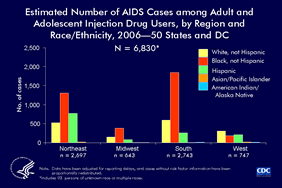
Slide 13
AIDS Rates for Adults and Adolescents, by Population
of Area of Residence and Region, Reported in 2006
50 States and DC
PDF
File
 or
PPT
File or
PPT
File |
|

Slide 14
Estimated Number of Adult and Adolescent Injection Drug Users Living with AIDS, by Sex, 2006—United States and Dependent Areas
PDF
File
 or
PPT
File or
PPT
File |
|

Slide 15
Estimated Number of HIV/AIDS Cases among Adults and Adolescents, by Transmission Category, 2003–2006—33 states
PDF
File
 or
PPT
File or
PPT
File |
|
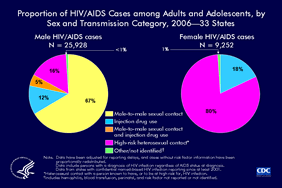
Slide 16
Proportion of HIV/AIDS Cases among Adults and Adolescents, by Sex and Transmission Category, 2006—33 States
PDF
File
 or
PPT
File
or
PPT
File |
|
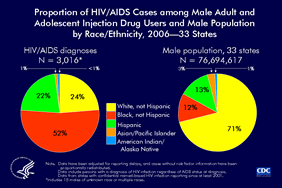
Slide 17
Proportion of HIV/AIDS Cases among Male Adult and Adolescent Injection Drug Users and Male Population by Race/Ethnicity, 2006—33 States
PDF
File
 or
PPT
File or
PPT
File |
|
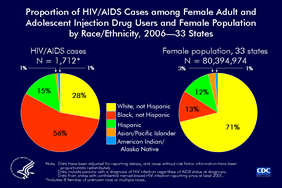
Slide 18
Proportion of HIV/AIDS Cases among Female Adult and Adolescent Injection Drug Users and Female Population by Race/Ethnicity, 2006—33 States
PDF
File
 or
PPT
File or
PPT
File |
|
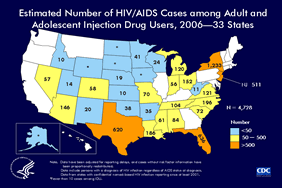
Slide 19
Estimated Number of HIV/AIDS Cases among Adult and Adolescent Injection Drug Users, 2006—33 States
PDF
File
 or
PPT
File or
PPT
File |
|
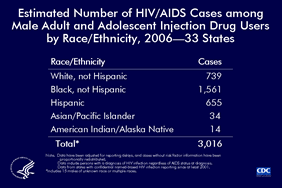
Slide 20
Estimated Number of HIV/AIDS Cases among Male Adult and Adolescent Injection Drug Users by Race/Ethnicity, 2006—33 States
PDF
File
 or
PPT
File or
PPT
File |
|
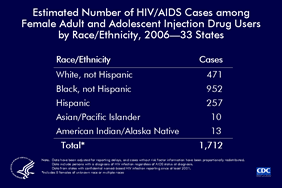
Slide 21
Estimated Number of HIV/AIDS Cases among Female Adult and Adolescent Injection Drug Users by Race/Ethnicity, 2006—33 States
PDF
File
 or
PPT
File or
PPT
File |
|
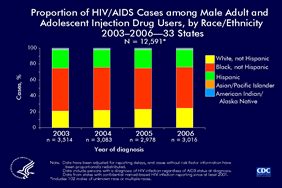
Slide 22
Proportion of HIV/AIDS Cases among Male Adult and Adolescent Injection Drug Users, by Race/Ethnicity 2003–2006—33 States
PDF
File
 or
PPT
File
or
PPT
File |
|
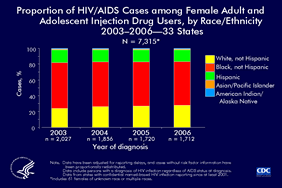
Slide 23
Proportion of HIV/AIDS Cases among Female Adult and Adolescent Injection Drug Users, by Race/Ethnicity, 2003–2006—33 States
PDF
File
 or
PPT
File or
PPT
File |
|
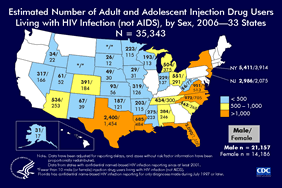
Slide 24
Estimated Number of Adult and Adolescent Injection Drug Users Living with HIV Infection (not AIDS), by Sex, 2006—33 States
PDF File
 or
PPT
File or
PPT
File |
|
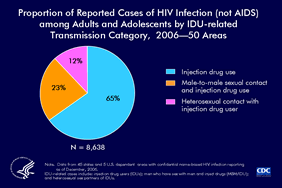
Slide 25
Proportion of Reported Cases of HIV Infection (not AIDS) among Adults and Adolescents by IDU-related Transmission Category, 2006—50 Areas
PDF
File
 or
PPT
File or
PPT
File |
|
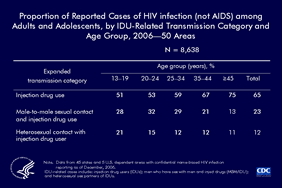
Slide 26
Proportion of Reported Cases of HIV infection (not AIDS) among Adults and Adolescents, by IDU-Related Transmission Category and Age Group, 2006—50 Areas
PDF
File
 or
PPT
File or
PPT
File |
|
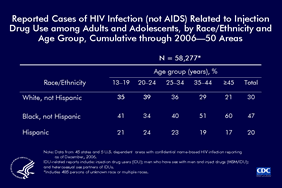
Slide 27
Reported Cases of HIV Infection (not AIDS) Related to Injection Drug Use among Adults and Adolescents, by Race/Ethnicity and Age Group, Cumulative through 2006—50 Areas
PDF
File
 or
PPT
File or
PPT
File |
|
|
|
|